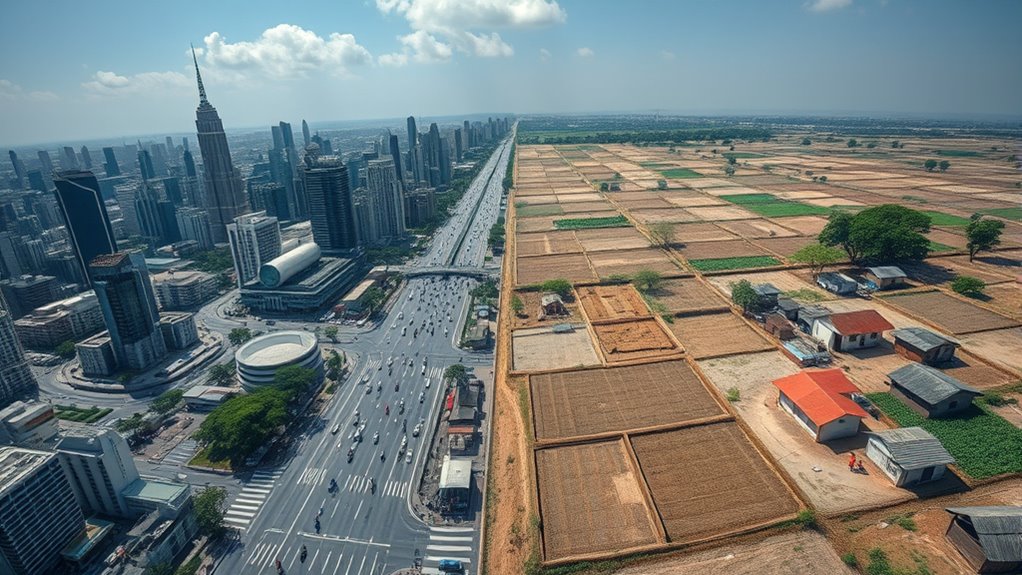Automation won’t hit the world equally. Advanced regions like North America and Europe lead due to better infrastructure and investments, while developing areas like Africa and Latin America adopt it more slowly. Industries, skill levels, and policies play significant roles in shaping this uneven spread. This means your job and industry could be impacted differently depending on where you are and your skills. If you’re curious about how these disparities could influence your future, there’s more to uncover.
Key Takeaways
- Regional disparities in automation are significant, with advanced economies leading and developing regions adopting automation more slowly.
- Industry-specific growth varies globally, with high-tech sectors benefiting more, while manufacturing and low-skill sectors face higher automation risks.
- Infrastructure, investment capacity, and regulatory environments influence how evenly automation impacts different regions.
- Developing countries may experience increased inequality and economic challenges due to slower adoption and digital infrastructure gaps.
- Policy support and technological infrastructure are essential for promoting equitable automation benefits worldwide.
The Global Landscape of Automation Adoption

Automation adoption varies considerably across regions, influenced by infrastructure, investment, and government policies. North America and Europe lead the way, thanks to advanced technology infrastructure and strong investment capabilities. Meanwhile, Asia-Pacific experiences the fastest growth, especially in China, Japan, and South Korea, driven by manufacturing automation and AI integration. In contrast, developing regions like Africa and Latin America adopt automation more slowly due to limited digital infrastructure and capital constraints. Within countries, adoption is uneven, favoring urban and industrialized areas over rural communities. Government policies also play a vital role; proactive initiatives accelerate adoption, while lack of support hampers progress. Overall, regional disparities shape the global automation landscape, creating a varied picture of how automation transforms industries worldwide. Regional disparities significantly impact the rate and nature of automation deployment across different parts of the world. Additionally, disparities in technological infrastructure can significantly influence the pace at which automation is integrated into various industries. Moreover, policy frameworks and economic incentives are crucial in determining how quickly and extensively automation is adopted in different regions. Furthermore, understanding the global automation trend is essential for developing strategies that address these disparities and promote more equitable technological growth. Recognizing the importance of digital infrastructure development can help bridge the gap between regions and accelerate automation adoption worldwide. As the automation landscape continues to evolve, understanding these regional differences becomes even more critical for policymakers and industry leaders.
Economic Growth and Industry Variances

You’ll notice that automation boosts economic growth more quickly in high-tech industries and advanced regions, creating uneven progress across sectors and locations. Smaller businesses often adopt automation at different rates based on costs and access to technology, affecting their growth potential. This variation influences regional economies, leading to shifts in industry dominance and economic disparities worldwide. Furthermore, the level of digital infrastructure and workforce skills significantly impact how quickly and effectively industries can implement automation technologies. As the costs of automation decrease and accessibility improves, more diverse sectors may experience accelerated growth, reducing some disparities over time. Additionally, technological adoption rates vary widely depending on local factors, further influencing the pace and distribution of automation’s economic impact. The availability of specialized automation tools like smart sensors and robotics also plays a crucial role in how effectively industries can leverage automation for growth. Moreover, the integration of automation systems depends heavily on existing technological ecosystems, which can either facilitate or hinder rapid adoption. It’s also important to consider the safety and reliability of automation technologies, which can affect their acceptance and implementation across different regions.
Industry Growth Disparities
Although industry growth from automation varies markedly across sectors and regions, some industries are experiencing more rapid advancements than others. Manufacturing and finance lead the way, driven by innovations like Industry 4.0, IIoT, and hyperautomation. The global industrial automation market is projected to reach USD 399.12 billion by 2029, highlighting strong growth in operational efficiency. Meanwhile, RPA is expected to hit $7.01 billion by 2025, transforming HR and finance functions. However, barriers like cost and complexity slow adoption in finance, where only 42% expect automation to have a significant impact. Regional dynamics also matter; North America is poised for high growth due to technological advancements. Overall, industries differ in their automation readiness, creating disparities in economic gains and competitive advantages. Self Watering Plant Pots are an example of how automation and innovative design can improve everyday tasks and resource management, illustrating the broader trend of technological integration across various sectors. Additionally, the pace of adoption is influenced by factors such as industry-specific regulations, which can either facilitate or hinder technological progression, and the varying levels of automation readiness among industries further contribute to global disparities. Furthermore, personality traits can affect how organizations adapt to technological changes and manage workforce transitions.
Regional Economic Shifts
Regional economic shifts are shaping how industries adopt automation and respond to global changes. You’ll notice that technological impacts, like AI and automation, are transforming 86% of businesses worldwide, creating new jobs while displacing others. Rising living costs and economic uncertainty slow growth, affecting 42%-50% of companies and shifting workforce demands. Geopolitical fragmentation, with trade restrictions and conflicts, disrupts supply chains, prompting demand for security and strategic roles. Meanwhile, the green transition drives growth in renewable energy and sustainability sectors, especially in regions focusing on climate adaptation. Demographic influences also matter—aging populations in high-income economies and expanding workforces in low-income regions shape workforce development. Advances in AI and automation are central to both job creation and displacement, and your region’s response depends on these factors, influencing economic growth and industry variances markedly. Moreover, the pace at which different regions integrate automation technologies can significantly alter their competitive advantages in the global market. Additionally, the adoption of health and safety protocols influenced by automation can reshape workplace environments and labor practices. Furthermore, the varying levels of technological infrastructure across regions determine how quickly and effectively automation can be implemented.
Technological Innovations Shaping Automation

Technological innovations are rapidly transforming automation, driving efficiency and expanding capabilities across industries. AI integration is revolutionizing supply chain management, optimizing inventory, demand forecasting, and decision-making. Robotics are increasingly used in warehouses to boost productivity and combat labor shortages. Physical AI enhances automation by embedding intelligence into physical systems, while the convergence of these technologies promises to cut costs and improve performance. Extended reality applications are being explored for training and simulations, making automation processes safer and more efficient. AI-driven predictive models enable predictive maintenance, reducing downtime, and improve forecasting accuracy. Smart manufacturing, with Industry 4.0, IoT, and cyber-physical systems, creates real-time data analysis and decentralized decision-making. Converging automation tools are simplifying integration, reducing setup complexity. Additionally, the adoption of cloud-based platforms supports seamless data sharing and system scalability in automated environments. These innovations collectively push automation forward, making industries more responsive and resilient.
The Evolving Workforce and Employment Changes

Advancements in automation are reshaping how workforces operate across industries, leading to significant shifts in employment patterns worldwide. You’ll see millions need to switch occupations as automation replaces jobs—around 7–24% of women and 8–28% of men globally. Traditional sectors like manufacturing have already lost 1.7 million jobs, and by 2030, nearly half of energy, utilities, and mining roles in North America face high automation risks. Retail jobs are also threatened, with about 41 million at risk by 2040. Meanwhile, managerial tasks are increasingly automated, with 69% expected to be fully automated soon. To stay relevant, you’ll need continuous reskilling in digital and tech skills, as automation transforms roles across sectors and regions. Emerging breakthrough technologies are expected to accelerate these changes, making adaptability more crucial than ever.
Regional Disparities in Automation Progress

As automation continues to accelerate, its impact varies considerably depending on local economic structures and workforce characteristics. Regions with economies reliant on manufacturing and low-skill service jobs face higher automation risks, especially in smaller, less-educated communities. Conversely, well-educated metropolitan areas along the Boston-Washington corridor and the West Coast have lower exposure, thanks to advanced skill ecosystems. Demographic factors like age, education, and industry influence regional vulnerability, with routine, low-skill workers being most at risk. Automation tends to benefit highly skilled workers in urban hubs, creating “winner-take-most” dynamics that deepen regional disparities. Less developed regions, lacking infrastructure and diversification, face economic challenges and increased inequality as automation accelerates, amplifying existing divides and concentrating gains in certain urban centers.
Impact on Productivity and Business Efficiency

Automation considerably boosts productivity by streamlining repetitive tasks and speeding workflows, allowing your team to focus on strategic work. It also helps reduce costs through process optimization and error minimization, leading to more efficient operations. As a result, your business can achieve higher output and better resource allocation, strengthening overall efficiency. Incorporating holistic practices like workflow analysis can further enhance the benefits of automation and ensure sustainable growth.
Boosts in Productivity
Boosts in productivity driven by automation are transforming how businesses operate, enabling you to complete tasks faster and more accurately. By 2025, automation could add $4.4 trillion to global productivity, according to McKinsey. With 94% of companies handling repetitive tasks, automation reduces manual work, boosting efficiency. Knowledge workers benefit too — 90% report improved jobs, and 66% see increased productivity. As AI integrates into workflows, more complex processes become automated, further enhancing output. The market for workflow automation is expected to reach $18.45 billion by 2025, showing rapid adoption. Additionally, understanding interest rates can help businesses make informed decisions about financing automation initiatives.
Cost Reduction Strategies
Implementing automation is a proven strategy for reducing operational costs and increasing overall business efficiency. Over the past decade, automation adoption has soared from 16% to over 51%, leading to average cost savings of 32%. In some processes, automation cuts costs by up to 90%, and companies investing heavily in automation typically reduce expenses more than twice as much as laggards. For example, retailers have seen a 22% cost reduction compared to just 8% for less-invested firms. Automation also lowers labor costs by automating repetitive tasks, freeing employees for strategic roles, and reducing training needs. Additionally, understanding the ethical hacking processes helps organizations safeguard their automated systems against vulnerabilities. These cost reductions improve ROI, streamline workflows, and enhance competitiveness—making automation a critical tool for businesses aiming to stay efficient and profitable. Moreover, leveraging essential oils can support employee wellness and productivity in automated workplaces by reducing stress and promoting focus. A comprehensive understanding of automation integration is essential for maximizing these benefits and ensuring seamless implementation across various business functions.
Operational Efficiency Gains
Operational efficiency gains are a primary goal driving organizations to adopt automation, as streamlining workflows directly impacts overall performance. By automating repetitive tasks, you can reduce manual work by 60-95%, freeing up your team to focus on strategic activities. Automation also boosts productivity for 66% of knowledge workers, making daily tasks less tedious. Many businesses see workflow automation as a competitive edge—about 75% recognize it as a market advantage. Combining automation with digital tools enables better management and smoother processes, leading to operational excellence. Additionally, leveraging AI Content Clusters to Outrank Competitors can further enhance automation strategies by creating targeted, interconnected workflows that optimize content management and performance. Implementing these advanced content strategies can significantly improve operational outcomes and content marketing success.
Challenges Facing Automation Expansion

Expanding automation faces a complex array of challenges that can hinder its growth despite technological advancements. Economic uncertainty, trade tariffs, and market fluctuations restrict short-term sales and investments. High initial costs limit smaller firms from adopting automation, while inconsistent regulations across regions complicate global deployment. Technologically, integrating AI, ensuring cybersecurity, and updating systems quickly pose hurdles. Environmental concerns and social acceptance also influence expansion, with job displacement and ethical issues creating resistance. Operational and organizational barriers, like process integration, further slow progress. To visualize these challenges:
| Economic & Market | Regulatory & Legal | Technological Challenges |
|---|---|---|
| Market volatility | Varying regulations | Cybersecurity threats |
| Investment costs | Data laws | Integration complexity |
| Trade policies | IP and standardization | Rapid obsolescence |
These obstacles demand coordinated efforts to overcome.
Future Outlook and Strategic Considerations

Despite the challenges faced in broadening automation, the outlook for its future remains highly promising. The global AI industry is set to grow exponentially, with a projected 5x increase in value over five years and a CAGR of 35.9% from 2025 to 2030. You’ll see more businesses investing heavily in AI—92% plan to boost their spending—and RPA market growth with a CAGR of 43.9%. This expansion will boost operational efficiency, deliver strong ROI, and reshape industries. As AI becomes central to strategic plans, expect a workforce transformation with up to 97 million people working in AI-related roles by 2025. Key considerations include embracing hyper-automation, aligning organizational strategies, and preparing for widespread workforce changes.
- Increased investment and adoption of AI and RPA
- Strong focus on operational efficiency and ROI
- Workforce transformation driven by automation
Frequently Asked Questions
How Will Automation Impact Income Inequality Worldwide?
You might notice that automation can widen income inequality worldwide. It replaces lower-skilled jobs and benefits capital owners more than workers, especially those with less education. Regions with better access to technology will see faster economic growth, while others fall behind. To address this, governments should invest in education, retraining, and social safety nets, ensuring automation benefits everyone rather than increasing disparities across nations and social classes.
What Industries Are Most Vulnerable to Job Displacement by Automation?
You should know that manufacturing, transportation, administrative, and retail sectors are most vulnerable to automation. Manufacturing jobs face significant displacement as robots replace physical tasks, while truck driving and warehousing are threatened by autonomous vehicles and robots. Administrative roles with routine tasks and retail jobs like cashiers are also at risk due to AI and automation. These industries will see major job shifts, with many roles evolving or disappearing altogether.
How Are Different Regions Preparing Their Workforce for Automation?
Did you know that 70% of emerging economies are investing heavily in infrastructure to support automation? You see, regions prepare their workforce differently: developed economies focus on upskilling, reforming education, and government support, while emerging economies prioritize infrastructure, basic skills training, and encouraging entrepreneurship. Asia leads in rapid adoption, whereas Africa faces infrastructure challenges. These strategies aim to help workers adapt and thrive in an increasingly automated world.
Will Automation Lead to Reduced Global Economic Disparities?
Automation alone won’t reduce global economic disparities; it often widens them. You’ll see advanced economies benefiting more quickly, boosting productivity and wealth, while emerging and low-income countries struggle with infrastructure and skills gaps. To address this, you need strategic investments in education, infrastructure, and international cooperation. These steps can help guarantee automation’s benefits are shared more equally, narrowing the gap instead of widening it.
What Policies Can Ensure Equitable Automation Benefits Globally?
You should focus on policies that promote fair distribution of automation gains worldwide. Invest in education and reskilling programs to help workers adapt, and support inclusive automation design to reduce biases. Implement progressive taxes and social safety nets to address inequality, while encouraging international cooperation for technology transfer and standards. By prioritizing these actions, you can help guarantee automation benefits are shared more equitably across all regions and populations.
Conclusion
As automation unfolds unevenly across the globe, it’s no coincidence that regions with advanced infrastructure and innovation hubs lead the charge, shaping a future where opportunity and challenge intertwine. Your role in steering this landscape depends on staying adaptable and forward-thinking, recognizing that technological progress often arrives where least expected. Embracing these shifts now could be the key to thriving in a world where automation and human ingenuity are more intertwined than ever.









